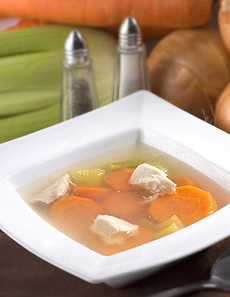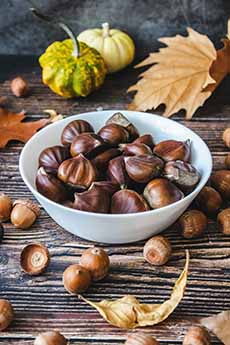
[1] Chestnuts drop from the trees in the fall. See photo #4 (photo © Tijana Drndarrski | Unsplash).
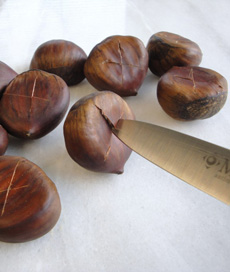
[2] Before roasting, make a cut in the shell so the steam can escape (photo © Chef Eddy).
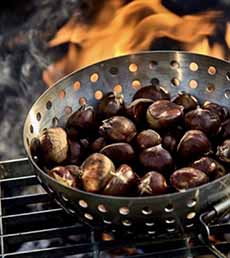
[3] You can roast the chestnuts in the oven, on the stovetop, or on a grill (photo © Sid Wainer).
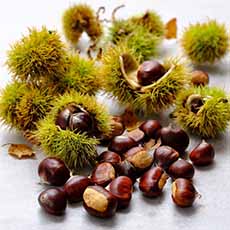 [4] The husk of the chestnut, also called the burr, is bright green and snazzy (photo © Umami Information Center | Facebook).
[4] The husk of the chestnut, also called the burr, is bright green and snazzy (photo © Umami Information Center | Facebook).
|
|
How would you like to roast your own chestnuts at home? Just the fragrant aroma of them is enough to make mouths water and fingers itch to peel them for snacking.
You don’t need a working fireplace to roast the chestnuts. Back in the old days, the fireplace was the only source of heat in the kitchen. Today, we have other options.
You can roast chestnuts in the oven in a pan, or on the stovetop with a special chestnut roasting pan. A chestnut roasting kit, complete with two pounds of chestnuts, is available at Melissas.com and elsewhere. It makes a nice family gift.
Compared to other nuts, chestnuts are composed chiefly of starch; other nuts have a larger percentage of protein.
The nutritional composition of chestnuts is similar to that of other starchy foods—corn, plantains, potatoes, etc. Yet, they are a better-for-you snack, a good source of minerals, vitamins, and some high-quality protein.
December 14th is Roast Chestnuts Day.
HOW TO ROAST CHESTNUTS
1. PREHEAT oven to 350°F. Cut an X on the flat side of each nut using a small, sharp knife. Be careful not to cut into the nutmeat.
2. OVEN ROASTING: Place the nuts in a single layer on an ungreased baking sheet and roast until the scored portions begin to curl up and the nuts release their fragrance, 15 to 20 minutes.
CHESTNUT PAN ROASTING: Heat the pan over medium-low heat and add the chestnuts. Cook, tossing the chestnuts frequently until the shells crack and the chestnuts are cooked through. The timing is 30 to 35 minutes over a gas flame burner or 35 to 40 minutes over an electric or induction burner.
3. REMOVE the nuts to a plate and eat immediately. Peeling the nuts is part of the fun, and each person may want to peel his or her own (or, you can peel all of them in the kitchen before serving). However, they are hot.
If the nuts are very hot, pick up individual nuts using a kitchen towel or other protection. Then with fingers or a knife, peel away the shell. Remove the inner skin, pop a nut into your mouth and enjoy.
THE CHRISTMAS SONG: LYRICS
“Chestnuts Roasting on an Open Fire” is the informal name of “The Christmas Song”; it was originally subtitled “Merry Christmas to You.” This Christmas classic was composed by Mel Torme and Bob Wells in 1946.
The most popular recording remains the first one, recorded by Nat King Cole. Here’s Nat King Cole on YouTube—the vocal track over a Christmas tree and fireplace visual.
You can sing along:
Chestnuts roasting on an open fire,
Jack Frost nipping on your nose,
Yuletide carols being sung by a choir,
And folks dressed up like Eskimos.
Everybody knows a turkey and some mistletoe,
Help to make the season bright.
Tiny tots with their eyes all aglow,
Will find it hard to sleep tonight.
They know that Santa’s on his way;
He’s loaded lots of toys and goodies on his sleigh.
And every mother’s child is going to spy,
To see if reindeer really know how to fly.
And so I’m offering this simple phrase,
To kids from one to ninety-two,
Although its been said many times, many ways,
A very Merry Christmas to you.
|









